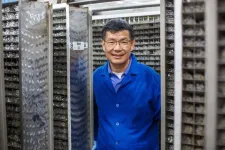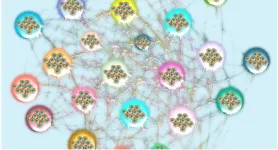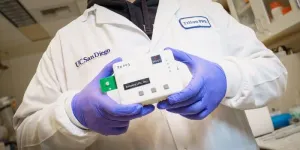(Press-News.org) JUPITER, Fla. — Slumbering among thousands of bacterial strains in a collection of natural specimens at The Herbert Wertheim UF Scripps Institute for Biomedical Innovation & Technology, several fragile vials held something unexpected, and possibly very useful.
Writing in the journal Nature Chemical Biology, a team led by chemist Ben Shen, Ph.D., described discovery of two new enzymes, ones with uniquely useful properties that could help in the fight against human diseases including cancer. The discovery, published last week, offers potentially easier ways to study and manufacture complex natural chemicals, including those that could become medicines.
The contribution of bacterial chemicals to the history of drug discovery is remarkable, said Shen, who directs the Natural Products Discovery Center at the institute, one of the world’s largest microbial natural product collections.
“Few people realize that nearly half of the FDA-approved antibiotics and anticancer drugs on the market are natural products or are inspired by them,” Shen said. “Nature is the best chemist to make these complex natural products. We are applying modern genomic technologies and computational tools to understand their fascinating chemistry and enzymology, and this is leading to progress at unprecedented speed. These enzymes are the latest exciting example.”
The enzymes the team discovered have a descriptive, if unwieldy, name. They are called “cofactorless oxygenases.” This means the bacterial enzymes pull oxygen from the air and incorporate it into new compounds, without requiring the typical metals or other cofactors to initiate the necessary chemical reaction.
This new way of synthesizing defensive substances would confer a survival advantage, enabling the organism to fend off infections or invaders. And because enzymes are to chemists what drill bits or saw blades are to a carpenter, they offer scientists new ways to create useful things, said the paper’s first authors, postdoctoral researchers Chun Gui, Ph.D., and Edward Kalkreuter, Ph.D.
Most immediately, the discovery of the enzymes, TnmJ and TnmK2, solves a lingering mystery of how a potential antibiotic and anticancer compound the Shen lab had first discovered in 2016, tiancimycin A, achieved such potency, Gui and Kalkreuter said.
The enzymes enable the bacteria to produce compounds for targeting and breaking up DNA, Gui said. This would be immensely useful in fighting off a virus or other germ — or killing cancer.
Tiancimycin A is being developed as part of a cancer-targeting antibody therapy. These types of combined antibody-drug therapeutics represent a rapidly growing new approach to fighting cancer. But a critical step to using tiancimycin A as an antibody’s payload is making enough to study it at a larger scale. That proved challenging.
“Even after we identified genes responsible for encoding tiancimycin A, several of the steps required to synthesize it could not be predicted,” Gui said. “The two enzymes described in the current study are highly unusual.”
Tiancimycin A was first found in a soil-dwelling bacteria, a type of Streptomyces from the strain collection at the Natural Products Discovery Center. To make its powerful chemical weapon, the organism had to solve a problem. It somehow had to break three highly stable carbon-carbon bonds and replace them with more reactive carbon-oxygen bonds. For a long time, the scientists couldn’t understand how the bacteria managed that feat.
Cracking the mystery involved finding other tiancimycin A-like natural product-producing bacteria among the institute’s Natural Products Discovery Center collection of 125,000 bacterial strains, and analyzing their genomes to search for the evolutionary hints.
The historic collection had long been housed in a pharmaceutical company’s basement, collected over decades following the discovery of penicillin in the scientific community’s hopeful rush to find the next great antibiotic. The collection did generate several historically important drugs through the years, including the tuberculosis antibiotic streptomycin and the organ transplant drug sirolimus. But the majority of the collection’s freeze-dried bacterial strains had rested in their glass vials, unexplored.
In 2018, Shen won a competition for the collection, so that it could be fully investigated in an academic setting, where it would be open to science. His team is now developing ways to study the strains, read their genomes and deposit the information into a searchable database for the scientific community to access. Modern genome sequencing and bioinformatics techniques are proving that there may be as many as 30 interesting gene clusters in each strain of bacteria they study, and many of them code for natural products never before documented by scientists, said Shen, who is a member of the UF Health Cancer Center.
The discovery of the new cofactorless enzymes is but the latest example of the chemical riches that lie within The Wertheim UF Scripps Institute's collection, Shen said. Their discovery has sparked new excitement about further investigating the reasons the unique chemistry evolved, and the ways it may prove useful.
“This publication underscores how many surprises nature still has for us,” Shen said, “It can teach us much about fundamental chemistry and biology and provide us with the tools and inspiration we need to translate laboratory findings into medicines that impact society and address many problems faced by humanity.”
END
Scientists discover key to a potential natural cancer treatment’s potency
Natural products collection reveals novel enzymes with surprising properties
2023-11-13
ELSE PRESS RELEASES FROM THIS DATE:
Mount Sinai researchers find more than 4,700 gene clusters crucial for prognosis in 32 cancer types
2023-11-13
New York, NY (November 13, 2023)—Researchers at the Mount Sinai Center for Transformative Disease Modeling have released a groundbreaking study identifying 4,749 key gene clusters, termed “prognostic modules,” that significantly influence the progression of 32 different types of cancer. The study, published in Genome Research, serves as a comprehensive resource and lays the foundation for the development of next-generation cancer treatments and diagnostic markers.
Despite significant progress in cancer research, understanding the disease's genetic intricacies ...
Ammonia fuel offers great benefits but demands careful action
2023-11-13
Ammonia, a main component of many fertilizers, could play a key role in a carbon-free fuel system as a convenient way to transport and store clean hydrogen. The chemical, made of hydrogen and nitrogen (NH3), can also itself be burned as a zero-carbon fuel. However, new research led by Princeton University illustrates that even though it may not be a source of carbon pollution, ammonia’s widespread use in the energy sector could pose a grave risk to the nitrogen cycle and climate without proper engineering precautions.
Publishing their findings in PNAS, the interdisciplinary team of 12 researchers found that a well-engineered ammonia economy could help the world achieve ...
Low-intensity fires reduce wildfire risk by 60%, study finds
2023-11-13
November 13, 2023-- There is no longer any question of how to prevent high-intensity, often catastrophic, wildfires that have become increasingly frequent across the Western U.S., according to a new study by researchers at Columbia University Mailman School of Public Health and Stanford University. The analysis reveals that low-intensity burning, such as controlled or prescribed fires, managed wildfires, and tribal cultural burning, can dramatically reduce the risk of devastating fires for years at a time. The findings are some of the first to rigorously quantify the value of low-intensity fire and be released while Congress is reassessing ...
Astrophysicist uses NSF funding to grow the number of deaf, hard-of-hearing, and Hispanic researchers
2023-11-13
Astrophysicist Jason Nordhaus is breaking cultural and disciplinary boundaries by helping to grow the number of deaf, hard-of-hearing, and Hispanic researchers. And, in doing so, he is enabling these future scientists to drive discoveries in one of his areas of expertise—neutron star astrophysics.
Nordhaus, an associate professor of physics at Rochester Institute of Technology’s National Technical Institute for the Deaf, has earned a National Science Foundation grant that connects NTID with Texas Tech University, a Hispanic Serving Institution. Through a series of unique summer research exchanges ...
A ‘fish cartel’ for Africa could benefit the countries, and their seas
2023-11-13
Banding together to sell fishing rights could generate economic benefits for African countries, which receive far less from access to their fisheries on the global market than other countries do from theirs. By joining forces, UC Santa Barbara researchers say in a paper published in the journal Nature Communications, African fisheries would not just secure more competitive access fees, they could also protect their seas’ biodiversity.
“If African countries created a ‘fish cartel’ to sell fishing rights to foreign vessels, they could increase their fish biomass by 16% and make 23% more in profits,” ...
Absorbable scaffold outperforms angioplasty for lower-leg artery disease
2023-11-13
In patients with severe artery blockage in the lower leg, an artery-supporting device called a resorbable scaffold is superior to angioplasty, which has been the standard treatment, according to the results of a large international clinical trial co-led by researchers at Weill Cornell Medicine and NewYork-Presbyterian.
Angioplasty involves the widening of a narrowed artery with a small, balloon-like mechanism. A resorbable scaffold is a stent-like structure that props the artery open but is biodegradable and dissolves within a few years, avoiding some of the potential complications of a permanent ...
New compound outperforms pain drug by indirectly targeting calcium channels
2023-11-13
A compound—one of 27 million screened in a library of potential new drugs—reversed four types of chronic pain in animal studies, according to new research led by NYU College of Dentistry’s Pain Research Center and published in the Proceedings of the National Academy of Sciences (PNAS).
The small molecule, which binds to an inner region of a calcium channel to indirectly regulate it, outperformed gabapentin without troublesome side effects, providing a promising candidate for treating pain.
Calcium channels play a central role in pain signaling, in part through the release of neurotransmitters such as glutamate and GABA— “the ...
This wireless, handheld, non-invasive device detects Alzheimer’s and Parkinson’s biomarkers
2023-11-13
An international team of researchers has developed a handheld, non-invasive device that can detect biomarkers for Alzheimer’s and Parkinson’s Diseases. The biosensor can also transmit the results wirelessly to a laptop or smartphone.
The team tested the device on in vitro samples from patients and showed that it is as accurate as the state of the art. Ultimately, researchers plan to test saliva and urine samples with the biosensor. The device could be modified to detect biomarkers for other conditions as well.
Researchers present their findings ...
Evolution of taste: Sharks were already able to perceive bitter substances
2023-11-13
A research team from the University of Cologne, in collaboration with colleagues from the Leibniz Institute for Food Systems Biology in Freising, has discovered a receptor for bitter taste in twelve different cartilaginous fish (sharks and rays). The receptor belongs to the so-called taste receptors type 2 (T2R), which also make humans perceive bitter and potentially toxic foods. Until now, it was assumed that such receptors only occur in bony vertebrates. The work was published under the title ‘A singular shark bitter taste receptor provides insights into the evolution of bitter taste perception’ ...
North Atlantic’s marine productivity may not be declining, according to new study of older ice cores
2023-11-13
To paraphrase Mark Twain, reports of declining phytoplankton in the North Atlantic may have been greatly exaggerated. A prominent 2019 study used ice cores in Antarctica to suggest that marine productivity in the North Atlantic had declined by 10% during the industrial era, with worrying implications that the trend might continue.
But new research led by the University of Washington shows that marine phytoplankton — on which larger organisms throughout the marine ecosystem depend — may be more stable than believed in the North Atlantic. The team’s analysis of an ice core going ...
LAST 30 PRESS RELEASES:
Statins significantly reduce mortality risk for adults with diabetes, regardless of cardiovascular risk
Brain immune cells may drive more damage in females than males with Alzheimer’s
Evidence-based recommendations empower clinicians to manage epilepsy in pregnancy
Fungus turns bark beetles’ defenses against them
There are new antivirals being tested for herpesviruses. Scientists now know how they work
CDI scientist, colleagues author review of global burden of fungus Candida auris
How does stroke influence speech comprehension?
B cells transiently unlock their plasticity, risking lymphoma development
Advanced AI dodel predicts spoken language outcomes in deaf children after cochlear implants
Multimodal imaging-based cerebral blood flow prediction model development in simulated microgravity
Accelerated streaming subgraph matching framework is faster, more robust, and scalable
Gestational diabetes rose every year in the US since 2016
OHSU researchers find breast cancer drug boosts leukemia treatment
Fear and medical misinformation regarding risk of progression or recurrence among patients with breast cancer
Glucagonlike peptide-1 receptor agonists and asthma risk in adolescents with obesity
Reviving dormant immunity: Millimeter waves reprogram the immunosuppressive microenvironment to potentiate immunotherapy without obvious side effects
Safety decision-making for autonomous vehicles integrating passenger physiological states by fNIRS
Fires could emit more air pollution than previously estimated
A new way to map how cells choose their fate
Numbers in our sights affect how we perceive space
SIMJ announces global collaborative book project in commemoration of its 75th anniversary
Air pollution exposure and birth weight
Obstructive sleep apnea risk and mental health conditions among older adults
How talking slows eye movements behind the wheel
The Ceramic Society of Japan’s Oxoate Ceramics Research Association launches new international book project
Heart-brain connection: international study reveals the role of the vagus nerve in keeping the heart young
Researchers identify Rb1 as a predictive biomarker for a new therapeutic strategy in some breast cancers
Survey reveals ethical gaps slowing AI adoption in pediatric surgery
Stimulant ADHD medications work differently than thought
AI overestimates how smart people are, according to HSE economists
[Press-News.org] Scientists discover key to a potential natural cancer treatment’s potencyNatural products collection reveals novel enzymes with surprising properties






